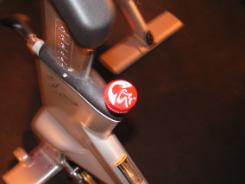In parts 1 and 2, I discussed two approaches to avoid when cueing resistance. In this (part 3) and the final article (part 4) in this important series, I will provide tips on how to teach the concept of resistance and inspire your riders to add enough so that they achieve the adaptations your profile is targeting.
This article describes the warm-up and provides cues for establishing that first touch of the resistance knob or gear level so riders can prepare the body at the proper intensity.
Your starting resistance is the most important resistance to establish
Cueing resistance effectively begins with establishing a baseline warm-up resistance for every class. It’s important that everyone finds their own baseline, not an artificial one declared by the instructor (as in number of turns, a gear, or a terrain scale). This happens during the warm-up with a cadence of anywhere from 75 to 90. While I do use the beat of the music to help establish cadence, and my personal preference is around 80–85 rpm, I’m usually not as adamant about riding a certain cadence during the first warm-up song because each student will warm up better at their own preferred cadence (as long as it’s not too slow due to high resistance or too fast that heart rate shoots up quickly). You can coach a more specific cadence to target adaptations later in the ride.
The terms “baseline” or “base plus” can be confusing if used without explanation or context. Make sure to read this article to understand how not to use it.
Low resistance does not mean NO resistance
There is no time when riding a stationary bicycle with zero resistance is beneficial, except possibly in a physical therapy session for the purposes of increasing mobility—never in a cycling class. An outdoor bicycle always has some resistance due to mechanical friction in the drivetrain, the road resistance against the tires, wind resistance, or the grade of the road. Outdoors, even when you are in the lowest gear you feel like you’re pushing against something.
Now imagine taking the chain off the bike and trying to pedal—the bike would not move forward and you would fall over. That would be no resistance!
Riding an indoor bike with zero resistance, especially models with heavier flywheels, is similar to riding a bike without a chain. Without the lack of forward movement to show them that they aren’t going anywhere, indoor students do not realize how ineffective this is. It is unfortunately prevalent in some classes to pedal at very high cadences with zero resistance. The analogy of riding without a chain may serve as a deterrent to some, although the fact that heart rate can still skyrocket even with no resistance may unfortunately make them believe they are doing work. They are not.
The good news is that some newer models such as the Stages SC series and Life Fitness IC7 bikes begin with a greater amount of resistance than older models. In other words, when you are pedaling at a reasonable cadence, you won’t see zero watts even if the dial is turned all the way to the left. This averts the situation of riders pedaling against nothing.
By establishing a baseline warm-up resistance, you begin the class with everyone at a similar level of resistance given the abilities and strengths of each student. Through your descriptive cues, you will guide riders to gradually start dialing in the road underneath them to a level of resistance that resembles a flat road in an easy gear.
Here are a variety of cues to express this concept during your warm-up:
In part 4 we will get into the meat of coaching resistance during the main body of your class.
[box]
For your review:
How to Coach Resistance in Your Indoor Cycling Class, Part 1
How to Coach Resistance in Your Indoor Cycling Class, Part 2
[/box]


I am just getting to read these articles. Great stuff! Any chance you could elaborate on this quoted comment in the article above or direct me to previous postings at ICA that address this phenomenon of high heart rate without doing true work. I am trying to find ways to explain this to my students who still associate high heart rate with work. “The analogy of riding without a chain may serve as a deterrent to some, although the fact that heart rate can still skyrocket even with no resistance may unfortunately make them believe they are doing work. They are not.” Thanks so much!
Thanks for this info! Very helpful! Even though there is similar archived info, I can get quite distracted going back in the archives because there’s so much great content! I have been teaching to RPE for a while but my descriptions have gotten kind of stale. It’s nice to have some new ways to describe the desired effort and I will be trying them tomorrow!
Also, it would be really great if there was a way to “star” or save an article to be able to refer to it again later on!
Thanks
yes, I first wrote a series on this topic in 2011, but I made a lot of changes this time around. I’ve evolved, technology has changed, and I write better now than I did 6 years ago when I first covered this (thanks to my editor)! 😉 You’ll see the most differences in the upcoming part 4.
We have a new website being designed right now. Thanks for you input. One of my goals is to make it easier to find archived content. We will be better at categorizing and tagging them so you can find what you are looking for more easily. I hadn’t thought about starring content; I’ll ask the web designer if it’s possible. One thing I do want to have is a segment of “most popular” articles.